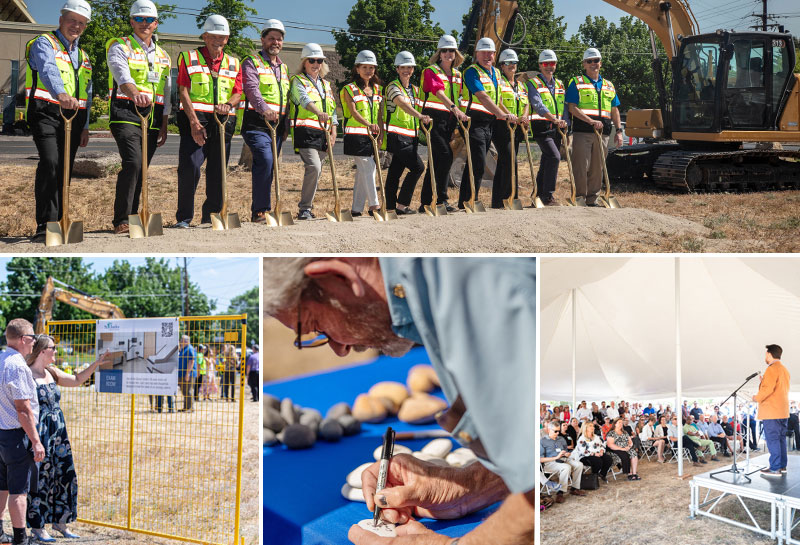The arrival of fellowship-trained surgeon Dr. Neil O’Kelly means breast cancer patients in Central Oregon now have the option of undergoing breast reconstructive surgery at St. Charles — and getting the care they need closer to home.
Dr. Linyee Chang, senior medical director of Cancer Services at St. Charles, says the arrival of O’Kelly is a milestone worth celebrating.
“Bringing Dr. O’Kelly to the Cancer Center shows our commitment to serving breast cancer patients in our community. We are thrilled to have such a well-trained, exceptional surgeon join us to help complete this incredible team,” said Dr. Chang. “I want our community to know that they can come to us for all things breast cancer — this is our area of expertise.”
O’Kelly’s arrival late last summer is the latest point of growth for the breast cancer program, which now includes early detection, genetic counseling, medical oncology, radiation oncology, a high-risk clinic and more. Breast cancer is the most common kind of cancer in Central Oregon, and St. Chares cares for about 200 patients every year.
The team will continue to grow to serve the community’s needs with the opening of the St. Charles Cancer Center in Redmond in 2026, where St. Charles will also offer a full complement of breast cancer services. Expansion of clinical trial options is also in the works, which will ultimately lead to a launch of the St. Charles Cancer Institute next year.
Dr. Caitlyn Truong, a fellowship-trained breast surgeon, joined the St. Charles team more than a year ago to support patients needing mastectomies and tumor removal surgeries. O’Kelly and Truong now work hand-in-hand — they even share an office — to support breast cancer patients who need surgery. After the cancer is removed, O’Kelly performs the reconstruction, a service that is in high demand. Prior to O’Kelly’s arrival, it was common for patients to travel out of the area for reconstructive surgery.
Kim Brinson, a 39-year-old breast cancer patient from Redmond, was “very grateful to have a reconstructive surgeon” in Central Oregon, she said. Brinson found a lump in her breast during a self-exam and ended up needing a mastectomy. She worked with O’Kelly to determine her options and ultimately underwent a double mastectomy and then a bilateral DIEP flap reconstruction.
O’Kelly says the reconstruction is a delicate surgery, in which he uses abdominal tissue to reconstruct a patient’s breasts.
“I would hate to travel for surgery,” said Brinson. “Having access in the area is amazing. O’Kelly is warm and caring and everything I would hope for in a doctor.”
She says the surgery removed her cancer with clean margins and she’s hopeful to not need any more treatment, so she can focus on spending time with her husband and two kids.
“I’m definitely feeling much better and am feeling relieved and ready to get back to regular life,” said Brinson.
The need in the community is one of the reasons that O’Kelly wanted to come to Central Oregon, after having studied at Johns Hopkins University for a microsurgery fellowship. “It’s hard to imagine having to travel out of state, while you are battling cancer, to have access to breast reconstruction," he said. "That’s a challenging path and I’m hopeful that people will find it a comfort and relief in having options closer to home.”
O’Kelly found his passion for plastic surgery during a rotation as a medical student at Georgetown University. “I like the wide array of surgeries that could be performed, especially with reconstruction.”
He quickly became interested in breast reconstruction specifically when he realized the powerful, positive impact his work could have on breast cancer patients.
“It gives us an opportunity to help the patient by restoring form after the removal of tissue to combat cancer. I am able to really help someone with a medical problem,” said O’Kelly. “A mastectomy or lumpectomy can be very challenging for patients to go through and breast reconstruction offers patients (a chance to) restore their self-image, which can have a big impact on quality of life after cancer. These reconstruction surgeries can have tremendous value for patients.”
If a woman chooses to undergo a mastectomy and desires reconstruction, she has many options including implant-based, tissue flap or free flap using microsurgical reconstruction with tissue from a patient’s body, often the abdomen. O’Kelly can perform all of these options and says it’s a partnership between the patient and surgeon to determine an individualized approach based on goals and preferences.
“It’s an extremely personal choice and it’s important to be able to offer all of the different options so that patients can select what will make them happiest in the long run,” said O’Kelly.
He also said he enjoys working alongside Truong and the team at the Cancer Center.
“Dr. Chang has built an amazing team of doctors in the center, who are very knowledgeable," he said. "Every single caregiver I’ve worked with has been wonderful.”
The plan is to treat several breast cancer patients per week in the Operating Room.
“There’s a tremendous need in the community," said O'Kelly, "and we are going to get busier and busier over time.”


